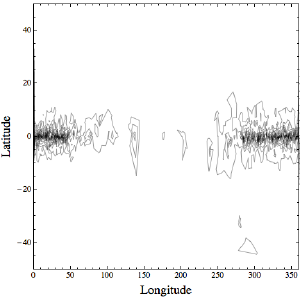Post
Mapping the Galaxy
4 June 2012
Previously I noted how the ionized gas between stars can slow down radio signals from pulsars and how the amount of slowdown depends on the frequency. Basically, higher frequencies travel a bit faster than lower frequencies. As a result, a radio pulse from a pulsar is widened in frequency by this ionized gas. The amount of pulse widening is known as the dispersion measure (DM). Since this pulse broadening only occurs when radio waves travel through ionized gas, you can use the dispersion measure to determine how much interstellar gas is between you and the pulsar. The bigger the DM, the more interstellar plasma.
 Brian Koberlein
Brian KoberleinWe have dispersion measures for about 2,000 pulsars in our galaxy, so we can use them to make a map of how interstellar gas is distributed. The result is plotted below. In the graph I’ve used galactic coordinates, which means zero degrees latitude is the plane of the milky way, and zero degrees longitude lies in the direction of galactic center. The result is pretty much what you would expect. Most of the interstellar gas lies in the same region as the stars and dust in our galaxy.
While the result is just what we would expect, the nice thing about this type of observation is that proves that there isn’t a halo of transparent interstellar gas surrounding our galaxy. So when we measure the odd behavior of galactic rotation we know we can’t use interstellar gas as an explanation. Instead we have to look to dark matter.
Even expected answers can prove useful in unexpected ways.